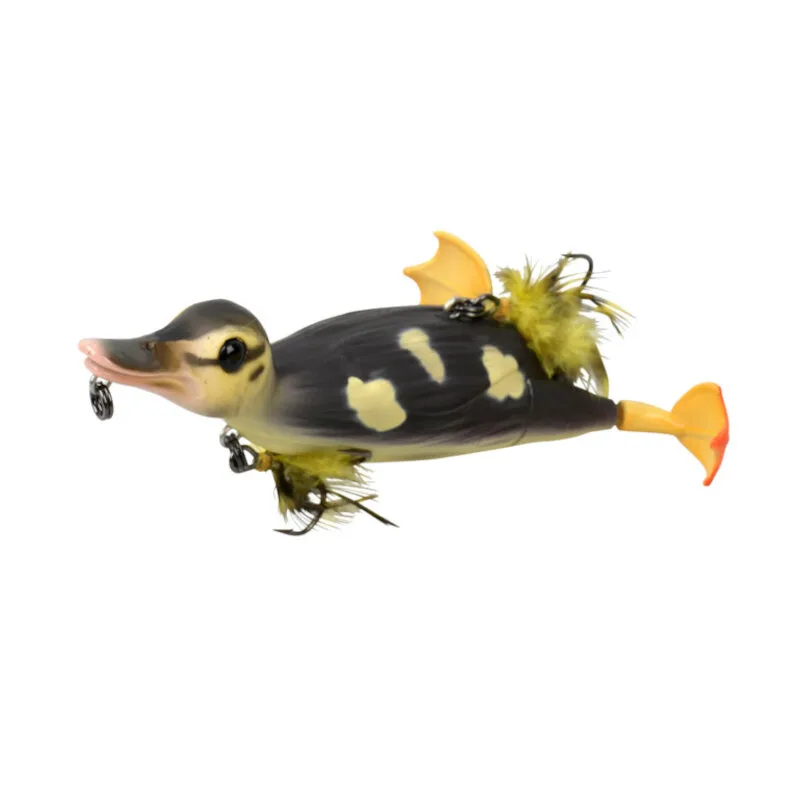In my series of lures for pike, the non-baitfish type lures were divided into three categories—frogs, rats, and finally, ducks. The article you are reading covers the last one on the list. So let’s see what’s the story behind duck lures for pike. The weirdest topwater lure I have seen.
What Are Duck Lures For Pike Made Of?
Duck lures designed for pike fishing are crafted from a variety of materials. Each chosen for its durability, buoyancy, and ability to replicate the natural movement and appearance of waterfowl. Here’s a breakdown of the primary materials commonly used in the production of duckling lures:
- Plastic: The most prevalent material is high-quality plastic. This material is lightweight, allowing for easy casting and retrieval. Plastics can be molded into various shapes and designs. This ensures that lures can effectively mimic the appearance and movement of ducks on the water’s surface. Advanced plastics also resist wear and tear from aggressive strikes, ensuring longevity even in challenging fishing conditions.
- Foam: Some duck lures incorporate foam materials into body construction, which helps enhance buoyancy. Foam not only keeps the lure floating at the surface, making it more visible to predatory fish like northern pike, but it also enables a more realistic swimming action. Foam construction can also provide a soft texture that adds to the lure’s lifelike feel when struck.
- Rubber and Silicone: These flexible materials are often used in the details of duck lures, such as in the wavey feet or wings. Rubber and silicone provide a natural movement in the water, mimicking the erratic motions of a duck struggling or moving in distress. Additionally, they are also resistant to damage from teeth and rough surfaces. This ensures that the lure maintains its integrity through multiple uses.
- Metal Components: Many duck lures feature metal parts, such as hooks or internal weight systems. These components are crucial for ensuring the lure’s stability and effectiveness. Metal hooks are designed for sharpness and durability, allowing anglers to secure their catch efficiently. Additionally, metal weights can help the lure achieve the desired depth and swimming action, making it versatile across various fishing environments. In other words, it can be used as a diving lure, not just for topwater fishing.
- Paint and Finishes: Just as it is with traditional lures, the visual appeal of duck lures is enhanced through the use of high-quality paints and finishes. They mimic the coloration of actual ducks. UV-resistant paints are often employed to maintain the lure’s vibrant colors in sunlight and prevent fading over time. This realism is critical in attracting pike, as they rely heavily on sight when hunting.
What Does Duckling Lure Looks Like?
The duckling lure, (I’ll use Savage Gear 3D Suicide Duck as an example), is designed to mimic the appearance of a real spring time duckling with remarkable detail and realism. At first glance, the lure features a vibrant, life-like coloration that closely resembles that of a duckling, complete with a rounded body that captures the essence of a young bird.
Beak: The lure is equipped with a finely sculpted beak that adds to its realistic aesthetic. It is designed to be subtle, reflecting the natural look of a duckling’s mouth. This helps to entice predator fish by suggesting an easy meal.
Legs: One of the standout features of the duckling lure is its semi-soft and durable feet. These legs are strategically designed to spin as the lure is retrieved. This creates a lively splashing action that simulates the frantic movement of a duckling trying to escape from a predator. This action not only attracts fish from a distance but also leaves a captivating bubble trail in the water.
Wings: While the lure does not feature traditional wings, the body shape and overall design evoke the presence of wings, enhancing the illusion of a swimming duckling. The lure’s contour helps it glide smoothly through the water, mimicking the natural motion of a duckling paddling along the surface.
Hooks: To ensure effective fishing, the duckling lure is fitted with two feather-covered treble hooks. One is located on the chest, and the other on the back, both designed to secure a solid hook-up when a fish strikes. For anglers who wish to fish in snag-prone areas, the belly treble hook can be easily removed, allowing for the safe belly landing of the lure, with the rear hook poised for action.

Is This a Killer Lure for Big Pike?
I used plenty of surface lures and I managed to hook a pike on a frog lure. A couple of times I tried to do the same with a rat lure, but no luck. However, when it comes to duck lure, I never even gave it a chance, even though I should.
The curiosity behind using duck lures stems from the pike’s natural predatory instincts. They are opportunistic feeders and tend to strike at whatever fits their thought of a meal. Ducks, being relatively sizeable and vulnerable creatures, can trigger significant interest from large pike, especially during certain times of the year.
So a definite answer to the question above is something you’ll have to look for on your own. Go ahead and try this lure as soon as spring starts, maybe you’ll be surprised by the outcome.
